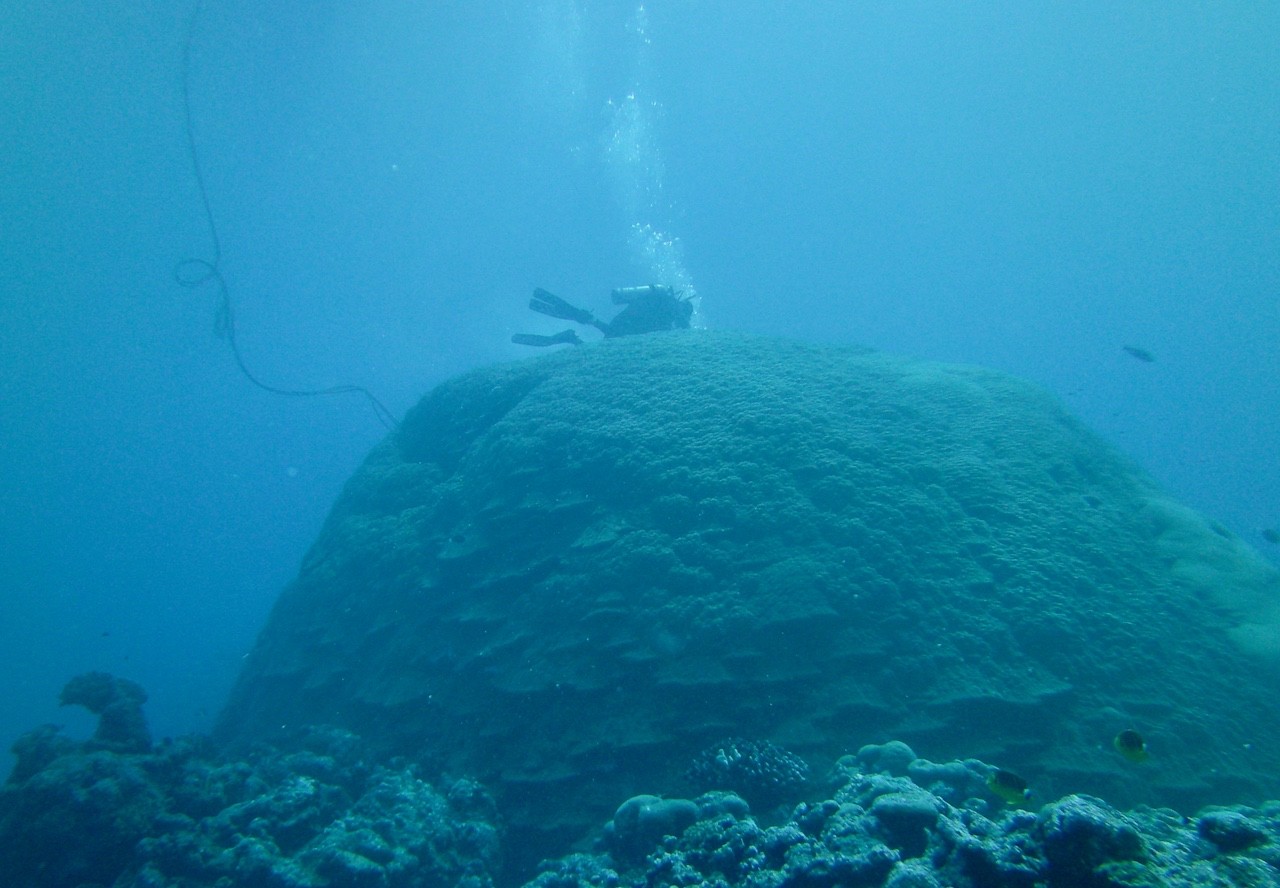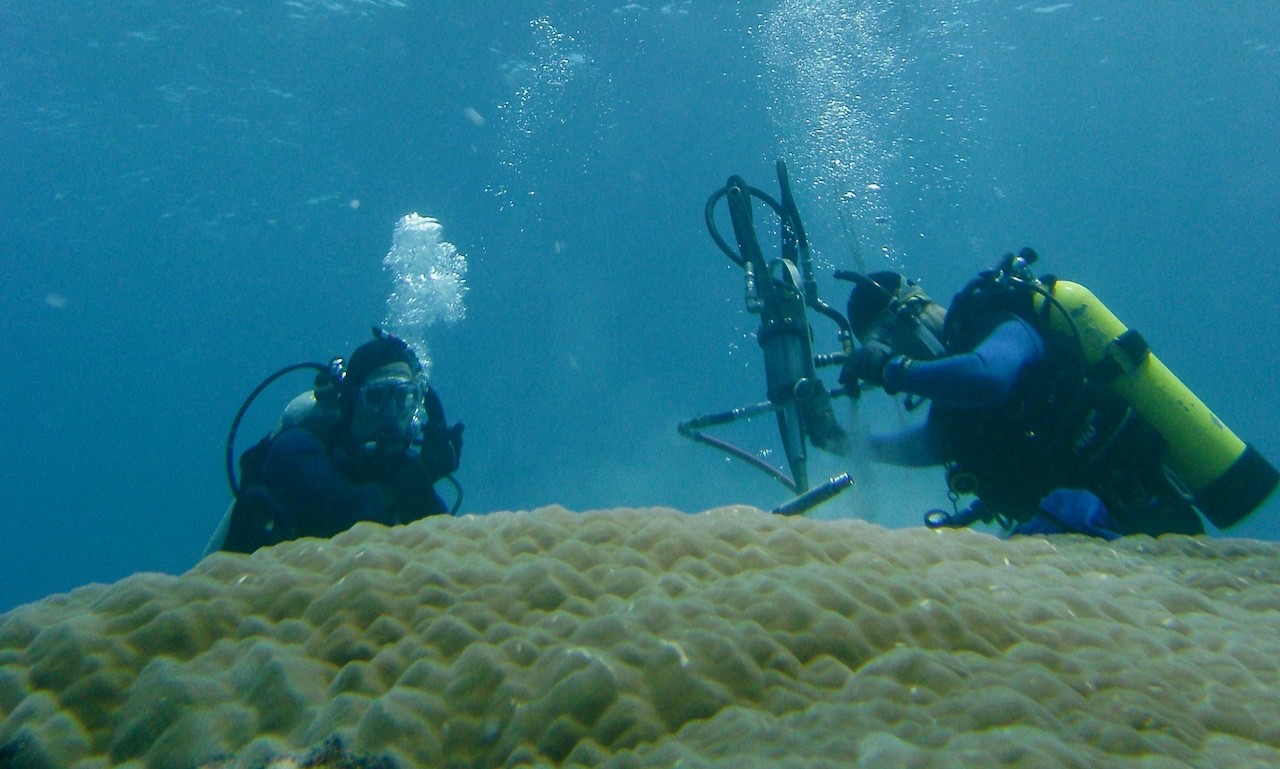New research funded by the Center for Climate and Life could provide insight into the global decline of coral reefs in the 20th century.

Over the last several centuries carbon isotopes in corals were related to their growth rates and water depth, but that relationship has changed in the last 30-40 years, says new research led by Braddock Linsley, a Lamont-Doherty Earth Observatory paleoceanographer and director of the Lamont Stable Isotope Laboratory. The finding, published in Nature Communications, could provide insight into the global decline of coral reefs in the 20th century.
Corals are increasingly stressed by warming temperatures and the growing amount of carbon dioxide (CO2) being absorbed by the ocean—a result of human dependence on fossil fuels. This excess CO2 may negatively impact coral calcification, the process by which corals produce the calcium carbonate that creates reefs. Improving understanding of the calcification process will enable scientists to interpret coral growth patterns of the past and provide a baseline by which to measure future changes.
For the new study, Linsley and his colleagues sampled five multi-century long coral cores from a broad region of the South Pacific and analyzed the ratio of carbon 13 to carbon 12 in these cores. Carbon isotope ratios have been measured in coral skeletons routinely over the years, but much of the data remains unpublished due to uncertainty over how to interpret it.
The results of their research show that annually averaged carbon isotope ratios are related to a coral’s growth rate. When corals grow more rapidly, there is more carbon 12 in the coral, and when there is more carbon 13, corals grow more slowly. For several hundred years, up to around 1950, this relationship between annually averaged coral carbon isotopes and skeletal growth rate was stable. But beginning in the middle of the 20th century, the relationship changed. Corals began recording increasing amounts of carbon 12 in their skeletons and their growth rate became progressively less correlated to skeletal carbon isotopes.
The study indicates the breakdown occurred when humans began using more fossil fuels, causing the amount of carbon 12 in the atmosphere to increase. Coral growth rates did not significantly increase or decrease after this change but varied in the normal range relative to the last several hundred years.
Scientists previously thought there was a relationship between carbon isotopes and coral growth rates. But Linsley’s research is the first to demonstrate that the relationship between carbon isotopes was relatively stable for at least several hundred years before the middle of the 20th century. The rapid rise in the amount of anthropogenic CO2 in the atmosphere appears to be related to the timing of the decoupling of coral growth and carbon isotopes, but scientists do not know exactly why.

Scientists previously thought there was a relationship between carbon isotopes and coral growth rates. But Linsley’s research is the first to demonstrate that the relationship between carbon isotopes was relatively stable for at least several hundred years before the middle of the 20th century. The rapid rise in the amount of anthropogenic CO2 in the atmosphere appears to be related to the timing of the decoupling of coral growth and carbon isotopes, but scientists do not know exactly why.
One implication of the finding is that the decoupling reflects a change in the coral calcification process and might be evidence of declining rates of photosynthesis of symbiotic algae living in the coral. Linsley projects that as corals record anthropogenic CO2 in seawater, and as that becomes more acidic, their growth rates could decline.
The study also examined the relationship between water depth, photosynthesis, and long-term average coral carbon isotope ratios on various corals from the Indo-Pacific and Atlantic Oceans. Previous studies proposed that carbon isotope ratios were related to the photosynthetic rate of the symbiotic algae in corals, yet the global data hadn’t been compiled.
Using data he collected and other published data, Linsley plotted the mean carbon isotope value of corals in relation to water depth from 1900 to 1950. He found a significant linear relationship: As water depth increases and there is less sunlight for photosynthesis, there is more carbon 12 in the coral skeleton.
This finding supports the hypothesis that mean coral skeleton carbon isotope ratios are related to rates of photosynthesis in the coral and could be used to produce more precise reconstructions of past sea level rise.
Linsley’s research was funded in part by a grant he received from the Center for Climate and Life to study coral bleaching in Tonga and Fiji. As Linsley began investigating coral growth rates and their relationship with carbon isotope ratios, the flexibility of the Center’s support enabled him to examine the existing data and assemble the historical record.
“This research is a good step forward in terms of interpreting what’s going on with this carbon isotope tracer,” said Linsley. “I hope it will lead to more of a community effort to discuss the data openly and get the data out there so we can move forward.”
Linsley’s next step is to determine whether the decoupling found in the South Pacific has occurred elsewhere on the planet. If it has, he’ll examine when, and how coral species in varied environments respond to increased amounts of anthropogenic CO2.
“We need to figure out what is potentially changing in the coral calcification process—if something has changed—and if it is going to eventually lead to negative impacts on reefs worldwide,” Linsley said.
The study was co-authored by Robert B. Dunbar, Emilie P. Dassié, Neil Tangri, Henry C. Wu, Logan D. Brenner, and Gerard M. Wellington.
— Renee Cho is a freelance writer who also contributes to the Earth Institute’s State of the Planet
